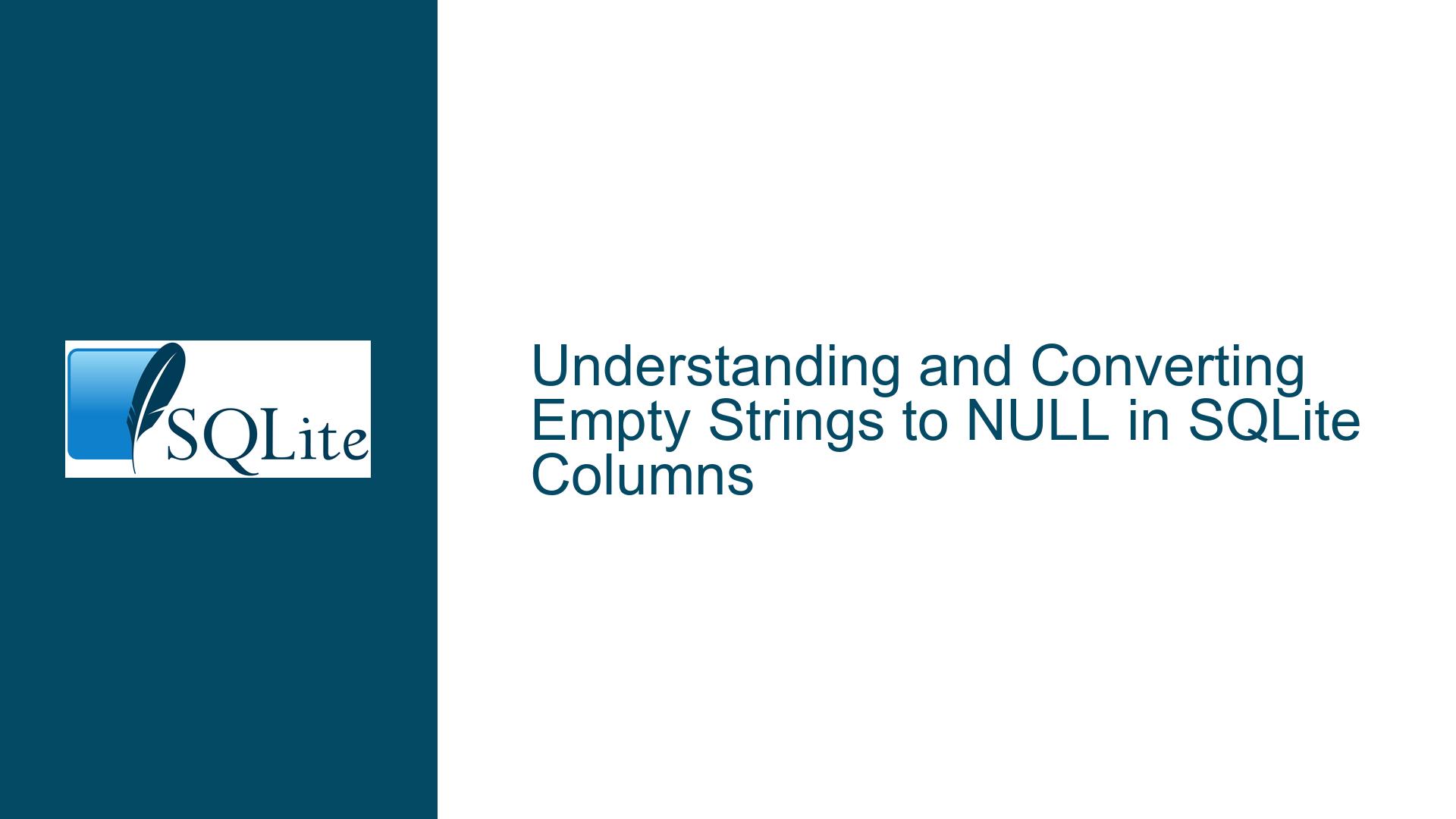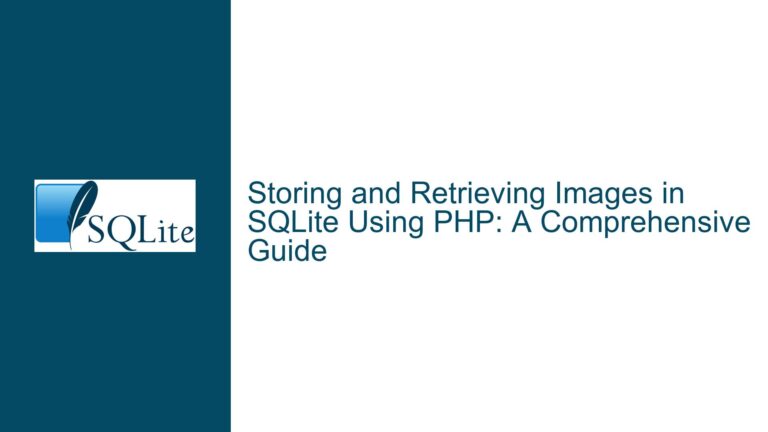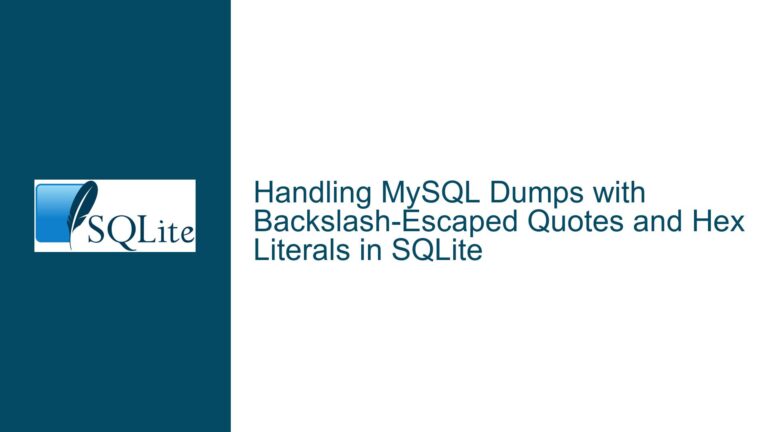and Converting Empty Strings to NULL in SQLite Columns
Distinguishing Between Empty Strings and NULL Values in SQLite
The core issue revolves around differentiating between empty string values ('') and NULL values in SQLite database columns. A user observed that a column contained numerous entries where the value was an empty string (''), confirmed by the query SELECT COUNT(*) FROM content WHERE fulltext = ''; returning 4,479 rows. However, the same column had zero entries where the value was explicitly NULL (SELECT COUNT(*) FROM content WHERE fulltext IS NULL;). This raised two critical questions:
What does an "empty" column (non-NULL) actually store?
The user initially speculated whether such columns contain ASCII 0 (a null character). This reflects a common misunderstanding about how SQLite handles empty strings versus NULL values.How to convert existing empty strings to NULL values?
The user sought a method to transform these empty strings into NULLs, which would align with practices where NULL represents the absence of data.
This guide addresses both questions by exploring SQLite’s type system, the behavior of empty strings and NULLs, and practical steps to manipulate these values.
SQLite Type System and Empty String vs. NULL Semantics
1. Empty Strings Are Valid Text Values
In SQLite, an empty string ('') is a valid text value with a length of zero. It is stored as a TEXT type, as demonstrated by the following example:
sqlite> CREATE TABLE x(x);
sqlite> INSERT INTO x VALUES (NULL), (''), (x'');
sqlite> SELECT x, typeof(x) FROM x;
┌──────┬───────────┐
│ x │ typeof(x) │
├──────┼───────────┤
│ NULL │ 'null' │
│ '' │ 'text' │
│ x'' │ 'blob' │
└──────┴───────────┘
Here, '' is explicitly recognized as TEXT, while NULL is its own type (null). This distinction is critical:
- Empty string (`”): A zero-length text value.
- NULL: Represents the absence of any value.
The confusion with ASCII 0 arises from conflating empty strings with null characters. ASCII 0 (\x00) is a valid character in strings but is distinct from an empty string. For example, 'a\x00b' is a 3-character string, whereas '' has no characters.
2. Oracle’s Non-Standard Behavior
Unlike SQLite, Oracle Database treats empty strings as equivalent to NULL. This divergence often causes confusion for users migrating from Oracle to SQLite. In Oracle:
SELECT '' IS NULL FROM dual; -- Returns TRUE
However, in SQLite (and most databases adhering to SQL standards):
SELECT '' IS NULL; -- Returns 0 (FALSE)
SELECT '' = NULL; -- Returns NULL (not FALSE)
This distinction ensures that empty strings and NULLs are handled unambiguously in SQLite.
3. Schema Design Implications
Allowing empty strings instead of NULLs can lead to unintended query results. For instance, aggregations like COUNT(fulltext) exclude NULLs but include empty strings. Similarly, WHERE fulltext IS NOT NULL would include rows with empty strings. Explicitly using NULL for "no data" ensures consistency.
Converting Empty Strings to NULLs: Solutions and Best Practices
1. Basic Conversion Using UPDATE
To replace empty strings with NULLs in the fulltext column:
UPDATE content
SET fulltext = NULL
WHERE fulltext = '';
This query targets rows where fulltext is an empty string and sets the value to NULL.
Key Considerations:
- Constraints: Ensure the column allows NULLs. If the column is declared
NOT NULL, the update will fail. - Indexes: Updating indexed columns may temporarily degrade performance. Rebuild indexes if necessary.
- Triggers: Check for
BEFORE/AFTER UPDATEtriggers that might interfere.
Verification:
After running the update:
SELECT COUNT(*) FROM content WHERE fulltext = ''; -- Should return 0
SELECT COUNT(*) FROM content WHERE fulltext IS NULL; -- Should return 4,479
2. Handling BLOBs and Other Types
Empty blobs (x'') are distinct from empty strings. To convert empty blobs to NULLs:
UPDATE content
SET fulltext = NULL
WHERE fulltext = x'';
3. Preventing Empty Strings via Constraints
To enforce NULLs instead of empty strings in future inserts:
CREATE TABLE content (
...,
fulltext TEXT CHECK(fulltext <> '')
);
This check constraint rejects empty strings, forcing applications to use NULL for missing data.
4. Data Type Affinity and Storage
SQLite uses dynamic typing, but columns have "type affinity" that influences storage:
- A
TEXTaffinity column stores''as text. - A
BLOBaffinity column storesx''as a blob.
Using typeof(fulltext) in queries clarifies the stored type. For example:
SELECT DISTINCT typeof(fulltext) FROM content;
5. Performance and Storage Optimization
- NULL Storage: NULLs are stored as a single-byte flag in SQLite’s record format.
- Empty Strings: Stored as a zero-length text value (minimal overhead).
While the storage difference is negligible, using NULLs can simplify query logic and improve readability.
Summary of Recommendations
- Use NULL for Absent Data: Reserve NULL for missing or inapplicable values. Avoid empty strings unless they have domain-specific meaning.
- Validate Inputs: Implement check constraints or application logic to reject empty strings where NULL is appropriate.
- Test Conversions: Always test
UPDATEstatements on a backup or staging database before applying them to production data. - Document Schema Decisions: Clearly document whether columns permit NULLs, empty strings, or both to avoid confusion.
By adhering to these practices, you ensure clarity in data representation and avoid pitfalls arising from conflating empty strings with NULLs.






